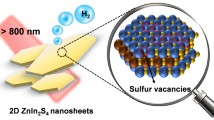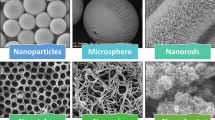Abstract
It is crucial to explore a facile synthesis of rutile TiO2 nanorods anchored at carbon cloth at low temperature for applicable air purifier. Herein, antler-like TiO2 rectangular bunched arrays were grown on carbon cloth by a hydrothermal method, and fluorine was doped into TiO2 with solid diffusion of NH4F at 300 °C. Fluorine doping induces oxygen vacancies in TiO2, facilitating the charge transfer and providing more active sites for photocatalytic reactions. The F doped TiO2 exhibits excellent photocatalytic oxidation of formaldehyde under UV and visible LED irradiation. UV–vis DRS and UPS results indicate that 3F-T@CC can harvest more visible light, and has the suitable energy band structure to generate hydroxyl radical and superoxide radical for the effective degradation of formaldehyde. EPR measurements prove the photogenerated superoxide radial (\(\cdot {\text{O}}_{2}^{ - }\)) and hydroxyl radical (·OH) are involved in oxidizing formaldehyde into CO2 and H2O.
Graphic Abstract

Photocatalytic degradation of formaldehyde by fluorine doped rutile TiO2 nanorod arrays on carbon cloth.










Similar content being viewed by others
References
Yang C, Miao G, Pi Y, Xia Q, Wu J, Li Z, Xiao J (2019) Abatement of various types of VOCs by adsorption/catalytic oxidation: a review. Chem Eng J 370:1128–1153
He C, Cheng J, Zhang X, Douthwaite M, Pattisson S, Hao Z (2019) Recent advances in the catalytic oxidation of volatile organic compounds: a review based on pollutant sorts and sources. Chem Rev 119:4471–4568
Liang Q, Bao X, Sun Q, Zhang Q, Zou X, Huang C, Shen C, Chu Y (2020) Imaging VOC distribution in cities and tracing VOC emission sources with a novel mobile proton transfer reaction mass spectrometer. Environ Pollut. 265:114628
Wang H, Xiang Z, Wang L, Jing S, Lou S, Tao S, Liu J, Yu M, Li L, Lin L, Chen Y, Wiedensohler A, Chen C (2018) Emissions of volatile organic compounds (VOCs) from cooking and their speciation: a case study for Shanghai with implications for China. Sci Total Environ 621:1300–1309
Cao J, Wu F, Wen M, Peng J, Yang Y, Dong H (2021) Adsorption mechanism of typical VOCs on pristine and Al-modified MnO2 monolayer. Appl Surf Sci. 539:148164
Zhang Z, Jiang C, Li D, Lei Y, Yao H, Zhou G, Wang K, Rao Y, Liu W, Xu C, Zhang X (2020) Micro-mesoporous activated carbon simultaneously possessing large surface area and ultra-high pore volume for efficiently adsorbing various VOCs. Carbon 170:567–579
Huang H, Chen C, Yang R, Yu Y, Albilali R, He C (2020) Remarkable promotion effect of lauric acid on Mn-MIL-100 for non-thermal plasma-catalytic decomposition of toluene. Appl Surf Sci 503:11
Mustafa MF, Fu X, Liu Y, Abbas Y, Wang H, Lu W (2018) Volatile organic compounds (VOCs) removal in non-thermal plasma double dielectric barrier discharge reactor. J Hazard Mater 347:317–324
Lyu J, Zhou L, Shao J, Zhou Z, Gao J, Li J, Dong Y, Wang Z (2020) Synthesis of TiO2/H2Ti3O7 composite with nanoscale spiny hollow hierarchical structure for photocatalytic mineralization of VOCs. Chem Eng J. 400:125927
Kim D, Yong K (2021) Boron doping induced charge transfer switching of a C3N4/ZnO photocatalyst from Z-scheme to type II to enhance photocatalytic hydrogen production. Appl. Catal. B. 282:119538
Diao W, Cai H, Wang L, Rao X, Zhang Y (2021) Efficient photocatalytic degradation of gas-phase formaldehyde by Pt/TiO2 nanowires in a continuous flow reactor. ChemCatChem 12:5420–5429
Guo Y, Wen M, Li G, An T (2021) Recent advances in VOC elimination by catalytic oxidation technology onto various nanoparticles catalysts: a critical review. Appl. Catal. B. 281:119447
Wang Z, Yu H, Xiao Y, Zhang L, Guo L, Zhang L, Dong X (2020) Free-standing composite films of multiple 2D nanosheets: synergetic photothermocatalysis/photocatalysis for efficient removal of formaldehyde under ambient condition. Chem Eng J 394:11
Singh S, Mahalingam H, Singh PK (2013) Polymer-supported titanium dioxide photocatalysts for environmental remediation: a review. Appl Catal A 462–463:178–195
Habibi-Yangjeh A, Asadzadeh-Khaneghah S, Feizpoor S, Rouhi A (2020) Review on heterogeneous photocatalytic disinfection of waterborne, airborne, and foodborne viruses: can we win against phthogenic viruses? J Colloid Interface Sci 580:503–514
Akhundi A, Habibi-Yangjeh A, Abitorabi M, Pouran SR (2019) Review on photocatalytic conversion of carbon dioxide to value-added compounds and renewable fuels by graphitic carbon nitride-based photocatalysts. Catal Rev 61:595–628
Dou H, Long D, Rao X, Zhang Y, Qin Y, Pan F, Wu K (2019) Photocatalytic degradation kinetics of gaseous formaldehyde flow using TiO2 nanowires. ACS Sustain Chem Eng 7:4456–4465
Zhu Z, Hong W, Chen C, Wu R (2020) Novel nanoarchitechtonics olive-like Pd/BiVO4 for the degradation of gaseous formaldehyde under visible light irradiation. J Nanosci Nanotechnol 20:2689–2697
Li X, Qian X, An X, Huang J (2019) Preparation of a novel composite comprising biochar skeleton and “chrysanthemum” g-C3N4 for enhanced visible light photocatalytic degradation of formaldehyde. Appl Surf Sci 487:1262–1270
Jin X, Zhou X, Sun P, Lin S, Cao W, Li Z, Liu W (2019) Photocatalytic degradation of norfloxacin using N-doped TiO2: optimization, mechanism, identification of intermediates and toxicity evaluation. Chemosphere 237:124433
Wang X, Wang C, Jiang W, Guo W, Wang J (2012) Sonochemical synthesis and characterization of Cl-doped TiO2 and its application in the photodegradation of phthalate ester under visible light irradiation. Chem Eng J 189–190:288–294
Fadlallah MM (2017) Magnetic, electronic, optical, and photocatalytic properties of nonmetal- and halogen-doped anatase TiO2 nanotubes. Phys E 89:50–56
Sun H, Wang S, Ang HM, Tadé MO, Li Q (2010) Halogen element modified titanium dioxide for visible light photocatalysis. Chem Eng J 162:437–447
Li D, Haneda H, Labhsetwar NK, Hishita S, Ohashi N (2005) Visible-light-driven photocatalysis on fluorine-doped TiO2 powders by the creation of surface oxygen vacancies. Chem Phys Lett 401:579–584
Elbanna O, Zhang P, Fujitsuka M, Majima T (2016) Facile preparation of nitrogen and fluorine codoped TiO2 mesocrystal with visible light photocatalytic activity. Appl Catal B 192:80–87
Samsudin EM, Abd Hamid SB, Juan JC, Basirun WJ, Kandjani AE, Bhargava SK (2016) Effective role of trifluoroacetic (TFA) to enhance the photocatalytic activity of F-doped TiO2 prepared by modified sol-gel method. Appl Surf Sci 365:57–68
Wu Y, Xing M, Tian B, Zhang J, Chen F (2010) Preparation of nitrogen and fluorine co-doped mesoporous TiO2 and photodegradation of acid orange 7 under visible light. Chem Eng J 162:710–717
Dozzi MV, D’Andrea C, Ohtani B, Valentini G, Selli E (2013) Fluorinr-doped TiO2 materials: photocatalytic activity vs time-resolved photoluminescence. J Phys Chem C 117:25586–25595
Dozzi MV, Artiglia L, Granozzi G, Ohtani B, Selli E (2014) Photocatalytic activity vs structural features of titanium dioxide materials singly doped or codoped with fluorine and boron. J Phys Chem C 118:25579–25589
Guo W, Xu C, Wang X, Wang S, Pan C, Lin C, Wang ZL (2012) Rectangular bunched rutile TiO2 nanorod arrays grown on carbon fiber for Dye-sensitized solar cells. J Am Chem Soc 134:4437–4441
Diao W, He J, Wang Q, Rao X, Zhang Y (2021) K, Na and Cl co-doped TiO2 nanorod arrays on carbon cloth for efficient photocatalytic degradation of formaldehyde under UV/visible LED irradiation. Catal Sci Technol 11:230–238
Hao Z, Chen Q, Dai W, Ren Y, Zhou Y, Yang J, Xie S, Shen Y, Wu J, Chen W, Xu GQ (2020) Oxygen-deficient blue TiO2 for ultrastable and fast lithium storage. Adv Energy Mater 10:1903107
Mazza T, Barborini E, Piseri P, Milani P, Cattaneo D, Li Bassi A, Bottani CE, Ducati C (2007) Raman spectroscopy characterization of TiO2 rutile nanocrystals. Phys. Rev. B 75:045416
Zhang Y, Harris CX, Wallenmeyer P, Murowchick J, Chen X (2013) Asymmetric lattice vibrational characteristic of rutile TiO2 as revealed by laser power dependent Raman spectroscopy. J Phys Chem C 117:24015–24022
Lei Y, Zhang LD, Meng GW, Li GH, Zhang XY, Liang CH, Chen W, Wang SX (2001) Preparation and photoluminescence of highly ordered TiO2 nanowire arrays. Appl Phys Lett 78:1125–1127
Howe RF, Gratzel M (1985) EPR observation of trapped electrons in colloidal TiO2. J Phys Chem 89:4495–4499
Czoska AM, Livraghi S, Chiesa M, Giamello E, Agnoli S, Granozzi G, Finazzi E, Di Valentin C, Pacchioni G (2008) The nature of defects in fluorine-doped TiO2. J Phys Chem C 112:8951–8956
Miyoshi A, Kuwabara A, Maeda K (2021) Effect of nitrogen/fluorine codoping on photocatalytic rutile TiO2 crystal studied by first-principle calculations. Inorg Chem 60:2381–2389
Banerjee S, Pillai SC, Falaras P, O’Shea KE, Byrne JA, Dionysiou D (2014) New insight into the mechanism of visible light photocatalysis. J Phys Chem Lett 5:2543–2554
Nosaka Y, Nosaka A (2016) Understanding hydroxyl radical (•OH) generation processes in photocatalysis. ACS Energy Lett 1:356–359
Nosaka Y, Nisaka A (2017) Generation and detection of reactive oxygen species in photocatalysis. Chem Rev 117:11302–11336
Acknowledgements
This work was supported by the National Natural Science Foundation of China (51801164), Fundamental Research Funds for Central Universities (XDJK2020C005), Venture & Innovation Support Program for Chongqing Overseas Returnees (cx2018080).
Author information
Authors and Affiliations
Contributions
The manuscript was written through contributions of all authors. All authors have given approval to the final version of the manuscript.
Corresponding authors
Additional information
Publisher's Note
Springer Nature remains neutral with regard to jurisdictional claims in published maps and institutional affiliations.
Supplementary Information
Below is the link to the electronic supplementary material.
Rights and permissions
About this article
Cite this article
Diao, W., Xu, J., Rao, X. et al. Facile Synthesis of Fluorine Doped Rutile TiO2 Nanorod Arrays for Photocatalytic Removal of Formaldehyde. Catal Lett 152, 1029–1039 (2022). https://doi.org/10.1007/s10562-021-03700-x
Received:
Accepted:
Published:
Issue Date:
DOI: https://doi.org/10.1007/s10562-021-03700-x




